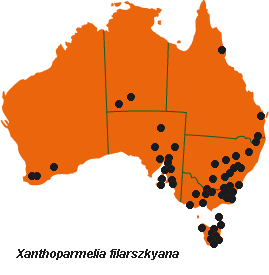



Australian Biological Resources Study
| Checklist of the Lichens of Australia and its Island Territories | ||
| Introduction | A–D | E–O | P–R | S–Z | Oceanic Islands | References | ||
| Xanthoparmelia filarszkyana (Gyeln.) Hale | ||
| Phytologia 28: 487 (1974); Parmelia filarszkyana Gyeln., Ann. Mycol. 36: 278 (1938). T: Round Swamp, Ogunbil, Tamworth, N.S.W., July 1906, W.Gardner; holo: BP. *****Parmelia praetermissa Kurok. & Filson, Bull. Natl Sci. Mus., ser. B, 1: 41 (1975). T: Olive Grove Station, 14.48 km south of Quorn, S.A., 30 Oct. 1970, R.B.Filson 11995; holo: MEL; iso: TNS. | ||
| Thallus foliose, tightly adnate, to 6–8 cm wide. Lobes barely imbricate, irregular, irregularly branched, 1–3 mm wide, laciniae lacking; marginal lobes with rotund apices. Upper surface pale yellow-green, darkening with age, dull, flat, emaculate, lacking soredia and isidia; older central lobes becoming rugose, developing transverse or irregular cracks and becoming areolate; lobe margins often black. Medulla white. Lower surface flat, pale tan to brown, blackening near lobe apices; rhizines moderately dense, short, slender, simple, concolorous. Apothecia sessile, 2–10 mm wide; disc deeply concave becoming ±flat, dark brown; thalline exciple smooth, entire, undulating. Ascospores 8–10 × 5–6 µm. Pycnidia common. Conidia bifusiform, 6–7 × 0.5 µm. CHEMISTRY: cortex K-, UV-; medulla K-, C-, KC+ rose, P-; containing usnic acid, ±loxodin, norlobaridone, ±protoconstipatic acid and ±constipatic acid; rarely containing conorlobaridone (trace) and conloxodin (trace). |  |
|
| Widespread and common, on rock throughout Australia (W.A., N.T., S.A., Qld, N.S.W., A.C.T., Vic. and Tas.); also on the South Is. of New Zealand. | ||
| Elix (1994z) | ||
| Checklist Index |
| Introduction | A–D | E–O | P–R | S–Z | Oceanic Islands | References |
This work is copyright. Apart from any use as permitted under the Copyright Act 1968, no part may be reproduced by any process without prior written permission from Australian Biological Resources Study. Requests and inquiries concerning reproduction and rights should be addressed in the first instance to Dr P. McCarthy. These pages may not be displayed on, or downloaded to, any other server without the express permission of ABRS.